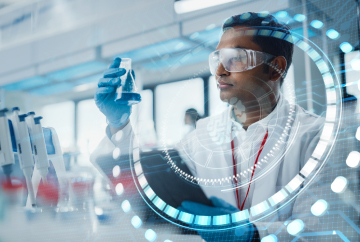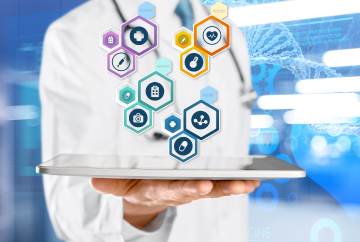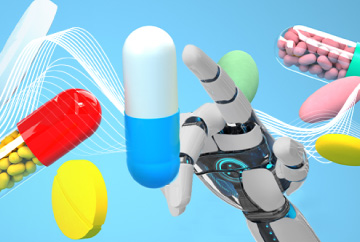What is Generative AI?
Generative AI is a subset of AI techniques, which can generate text, image and video content based on the data it has been trained on. Generative AI uses Generative Adversarial Networks (GANs), a technique that uses two competing neural networks to create new data from the inputs.
Generative AI applications exploit the ability of this technology to synthesize, summarize, describe and create new data in different (and sometimes multiple) media – for example, to generate or label X-ray images or to summarize a patient's medical history.
The potential of Generative AI in life sciences and healthcare
The scope and variety of applications of Generative AI are massive in the life sciences value chain, especially because of the volumes of unstructured data involved in this domain. Estimates suggest that the market for Generative AI in healthcare will reach $1bn+ by 2032, up from $160mn in 2022.
Life sciences businesses have already begun exploiting the technology, according to a report ~35% of companies have invested in it so far, with another 25% exploring potential use cases. Some of these have achieved differentiating outcomes with Generative AI within a short period. For example, one company discovered an AI-generated molecule for idiopathic pulmonary fibrosis, which is already in Phase II clinical trials.
Generative AI use cases in the life sciences value chain
Generative AI use cases by business functions
R&D and Manufacturing
Pharmaceuticals and medtech companies are leveraging Generative AI to power core aspects of their R&D and Manufacturing workflows. Here are some key applications:
- Pharmaceuticals are using Generative AI to gain insights into drug behavior, identify compounds likely to be good candidates to target a specific disease and gain better insights into disease pathology.
- Generative AI can also help in modelling, simulation and planning of trials, improve drug registration processes and clinical trial reporting cutting the time required for regulatory submissions.
- Generative AI can make manufacturing operations more efficient and streamlined with process optimization, identification of bottlenecks, quality control and machine automation and optimization.
- Medtech and medical device manufacturers can significantly reduce product ideation and prototyping timelines by using Generative AI in product design and for customizing implants and prosthetics for individual patients.
Supply chain
From healthcare providers to pharmaceuticals, Generative AI can significantly improve supply chain (SC) performance through:
- Analyzing data from multiple sources to generate more precise demand forecasts for drugs and medical devices – thereby optimizing inventory management and improving SC efficiency.
- Improving quality assurance outcomes by generating more realistic and varied test images, enabling algorithms to consistently catch anomalies and defects.
- Enabling faster contract analysis and enhancing supplier negotiation outcomes using chatbots powered by Generative AI. These applications are especially valuable in medtech and pharmaceutical verticals.
Sales and marketing
Generative AI is already seeing rapid adoption in sales and marketing across other industries like retail. Here are three ways in which it can be applied in life sciences:
- Generating communication targeted at stakeholder groups like physicians and patients and other key opinion leaders (KOLs). For example, healthcare providers can accelerate the creation of tailored communication to patients for improved care outcomes, whereas pharmaceutical companies can summarize and synthesize information on new therapies for physicians.
- Assist sales teams by concisely summarizing the key insights from lengthy scientific publications to better pitch new products to physicians or patients.
- Create visual marketing content to demonstrate complex scientific concepts to target groups in a more comprehensible form.
Services and operations
In the life sciences industry, services and operations overheads amount to a significant chunk of the overall spending. Here are the key use cases that can lower this spending and increase profitability:
- Translating product-specific data, marketing material and compliance documents like drug submission files to the languages of the respective regions of operation.
- Analyze data from significant adverse event reports to identify drug safety signals that might be missed by human analysis alone and enable more optimal clinical trial design by analyzing past patient data, scientific papers and historical trial results.
- Enabling service personnel like contact center staff to handle a greater volume of tickets through Generative AI-powered chatbots.
Generative AI use cases in key life sciences and healthcare verticals
In addition to the above functional applications, Generative AI’s vertical-specific applications have also yielded promising results. Here’s how the life sciences value chain is applying the technology today.
Pharmaceuticals
The pharmaceutical sector spends considerable resources on drug discovery, of which less than 10% result in breakthroughs as per a report. Generative AI can help pharma players increase this number through their ability to analyze the chemical properties of compounds and biological targets to propose viable candidates for new therapies. It can also optimize the subset of compounds to be screened in high-throughput experiments and simulate molecular dynamics to better understand drug behavior.
Moreover, Generative AI can also synthesize efficacy data of drugs to suggest personalized therapies and drugs for various patient categories. This can be achieved through recommendations of specific formulations or highly optimized doses based on disease treatment outcomes and historical data – a practice that is called precision medicine.




